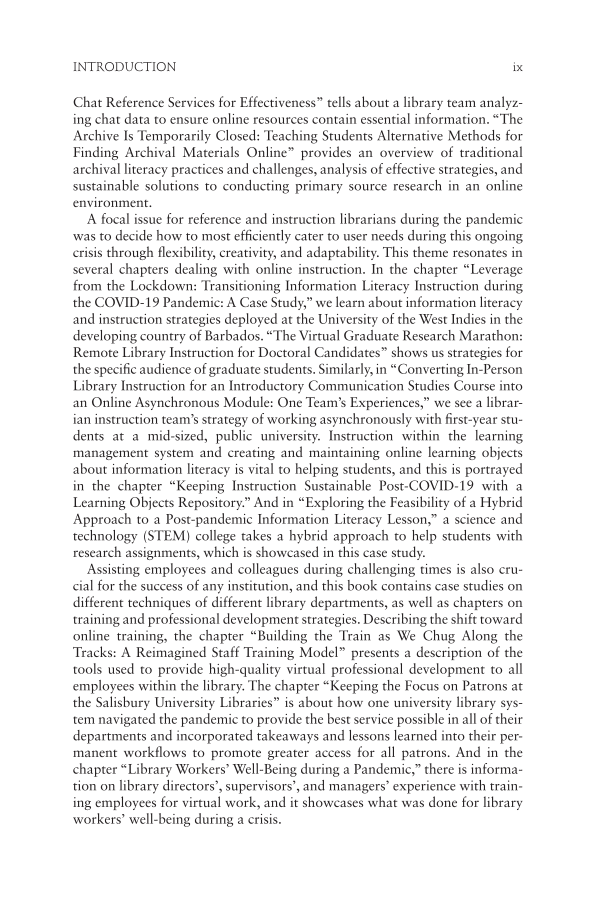Introduction ix Chat Reference Services for Effectiveness” tells about a library team analyz- ing chat data to ensure online resources contain essential information. “The Archive Is Temporarily Closed: Teaching Students Alternative Methods for Finding Archival Materials Online” provides an overview of traditional archival literacy practices and challenges, analysis of effective strategies, and sustainable solutions to conducting primary source research in an online environment. A focal issue for reference and instruction librarians during the pandemic was to decide how to most efficiently cater to user needs during this ongoing crisis through flexibility, creativity, and adaptability. This theme resonates in several chapters dealing with online instruction. In the chapter “Leverage from the Lockdown: Transitioning Information Literacy Instruction during the COVID-19 Pandemic: A Case Study,” we learn about information literacy and instruction strategies deployed at the University of the West Indies in the developing country of Barbados. “The Virtual Graduate Research Marathon: Remote Library Instruction for Doctoral Candidates” shows us strategies for the specific audience of graduate students. Similarly, in “Converting In-Person Library Instruction for an Introductory Communication Studies Course into an Online Asynchronous Module: One Team’s Experiences,” we see a librar- ian instruction team’s strategy of working asynchronously with first-year stu- dents at a mid-sized, public university. Instruction within the learning management system and creating and maintaining online learning objects about information literacy is vital to helping students, and this is portrayed in the chapter “Keeping Instruction Sustainable Post-COVID-19 with a Learning Objects Repository.” And in “Exploring the Feasibility of a Hybrid Approach to a Post-pandemic Information Literacy Lesson,” a science and technology (STEM) college takes a hybrid approach to help students with research assignments, which is showcased in this case study. Assisting employees and colleagues during challenging times is also cru- cial for the success of any institution, and this book contains case studies on different techniques of different library departments, as well as chapters on training and professional development strategies. Describing the shift toward online training, the chapter “Building the Train as We Chug Along the Tracks: A Reimagined Staff Training Model” presents a description of the tools used to provide high-quality virtual professional development to all employees within the library. The chapter “Keeping the Focus on Patrons at the Salisbury University Libraries” is about how one university library sys- tem navigated the pandemic to provide the best service possible in all of their departments and incorporated takeaways and lessons learned into their per- manent workflows to promote greater access for all patrons. And in the chapter “Library Workers’ Well-Being during a Pandemic,” there is informa- tion on library directors’, supervisors’, and managers’ experience with train- ing employees for virtual work, and it showcases what was done for library workers’ well-being during a crisis.
Document Details My Account Print multiple pages
Print
You have printed 0 times in the last 24 hours.
Your print count will reset on at .
You may print 0 more time(s) before then.
You may print a maximum of 0 pages at a time.













































































































































































































































































